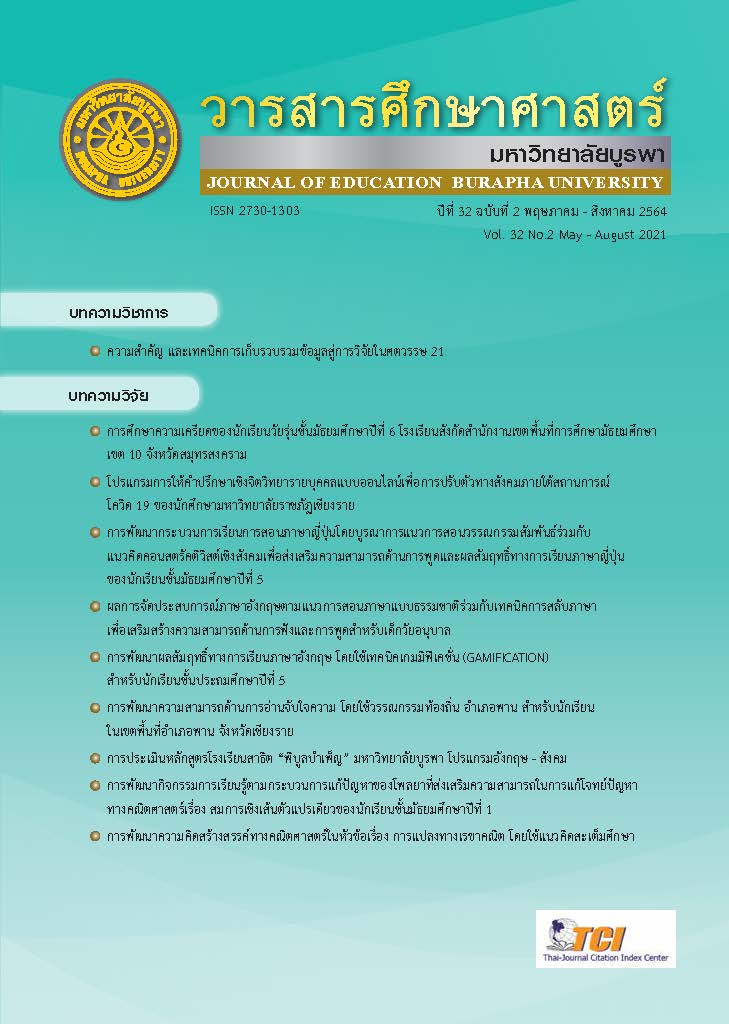การพัฒนาความคิดสร้างสรรค์ทางคณิตศาสตร์ในหัวข้อเรื่อง การแปลงทางเรขาคณิต โดยใช้แนวคิดสะเต็มศึกษา
คำสำคัญ:
การแปลงทางเรขาคณิต, ความคิดสร้างสรรค์ทางคณิตศาสตร์, สะเต็มศึกษาบทคัดย่อ
งานวิจัยนี้มีวัตถุประสงค์ คือ เพื่อศึกษาการพัฒนาความคิดสร้างสรรค์ทางคณิตศาสตร์ของนักเรียนชั้นมัธยมศึกษาปีที่ 2 ที่ได้รับการจัดการเรียนรู้ตามแนวคิดสะเต็มศึกษา กลุ่มตัวอย่างเป็นนักเรียนชั้นมัธยมศึกษาปีที่ 2 จำนวน 30 คน ของโรงเรียนวัดตะวันเรือง ซึ่งได้มาจากการสุ่มแบบเฉพาะเจาะจง เครื่องมือที่ใช้ในการวิจัยประกอบด้วยแผนการจัดการเรียนรู้ตามแนวคิดสะเต็มศึกษาในหัวข้อการแปลงทางเรขาคณิตและแบบวัดความคิดสร้างสรรค์ทางคณิตศาสตร์ สถิติที่ใช้ในการวิเคราะห์ข้อมูล ได้แก่ ค่าเฉลี่ย ส่วนเบี่ยงเบนมาตรฐาน ค่า Class normalized gain และการบันทึกพฤติกรรมของนักเรียนหลังการจัดการเรียนรู้ตามแนวคิดสะเต็มศึกษา
ผลการวิจัยปรากฏว่า ความคิดสร้างสรรค์ทางคณิตศาสตร์ของนักเรียนชั้นมัธยมศึกษาปีที่ 2 ที่ได้รับการจัดการเรียนรู้ตามแนวคิดสะเต็มศึกษา หลังเรียนสูงกว่าก่อนเรียน โดยนักเรียนมีคะแนนพัฒนาการความสามารถในการคิดสร้างสรรค์ทางคณิตศาสตร์ (Class normalized gain) เท่ากับ 0.44 ซึ่งอยู่ในระดับปานกลาง และระหว่างการสังเกตพฤติกรรมการจัดการเรียนรู้ตามแนวคิดสะเต็มศึกษา พบว่า นักเรียนสามารถแสดงความคิดสร้างสรรค์ทางคณิตศาสตร์ได้ครบทั้ง 4 องค์ประกอบ โดยแสดงด้านความคิดคล่องได้ชัดเจนที่สุด
เอกสารอ้างอิง
Engineering, and Mathematics Education. Preparing students for the 21st Century by
Prof. Dr. Edward R. Reeve. 15 May 2012. at Sanan Sumit Hall The Institute for the
Promotion of Teaching Science and Technology.
Aree Phanmanee. (2004). Trained to think a creatively. Khaofang Publisher, Bangkok.
Chantana SonKongdang. (2008). The results of teaching by using project-based learning on skills
in the process of teaching science and academic achievement of science subjects of
grade 4 students.Master of Education Thesis (Curriculum and Instruction). Nakhon
Sawan Rajabhat University. Nakhon Sawan.
Hake, RR. (1998). Interactive-Engagement Versus Traditional Methods: A Six-Thousand-Student
Survey of Mechanics Test Data for Introductory Physics Courses. American Journal of
Physics. Vol.66. pp.64-67.
James B. Schreiber, Kimberly Asner-self. (2011). Educational Research, John Wiley & Sons. 111
River street.Hoboken.
Ontida Swang. (2017). The study on mathematical creative thinking in originality aspect suing
problem-based. Master Degree Thesis. Ubon Ratchathani. Mathematics.
Passorn Tidma, Maliwan Nakkuntod and Sirinapa Kijkuakul. (2015). STEM Education in the topic
of Human Systems to promote creative thinking of 8th Grade Students. Master
Degree Thesis. Naresuan University. Education.
Patcharin Setteechaichane. (2019). A study of the achievement of analytical geometry in three-
dimensional space. For high school students. King Mongkut's University of Technology
Thonburi. pp. 75-77.
Pornthip Siripatrachai. (2013). “STEM Education and Development in 21 Century: Bangkok
University”. Journal of Administration. Yrs. 33 ep.2 April-June 2013 .pp 49-56.
Prapapron urai. (2006). The Development of Mathematics Learning Activities with The
Emphasis on Creative Thinking for Prathom Suksa II Students. Master of
education in Elementary Education Graduate School Khonkean University.
The Institute for the Promotion of Teaching Science and Technology (IPST). (2012). Skill and
Process of Mathematics. Bangkok.
Vicharn Panich. (2012). How to create learning for students in 21 st century. Sodsrisriwong
Foundation. Bangkok.
ดาวน์โหลด
เผยแพร่แล้ว
รูปแบบการอ้างอิง
ฉบับ
ประเภทบทความ
สัญญาอนุญาต
บทความทุกบทความเป็นลิขสิทธิ์ของวารสารศึกษาศาสตร์ มหาวิทยาลัยบูรพา



